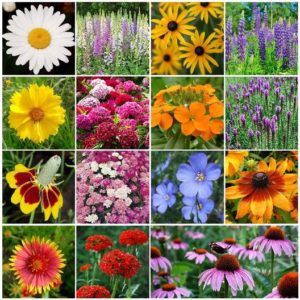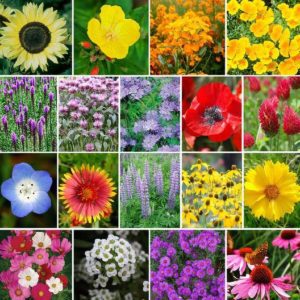You may have noticed quite a lot of momentum building behind the movement to plant more wildflowers in the last several years—and for good reason. Wildflowers are an important part of the local ecosystem within your community and play a vital role in the success of countless species of native fauna from insects to birds and mammals. With communities and municipalities becoming more educated about the issues with growing vast expanses of lawn, as well as the pivotal role native flora plays in ensuring our local environment is maintained, we’re on the cusp of a landscaping revolution. Wildflowers are at the forefront of this discussion. Here are 4 reasons why.
Natural Beauty
Beauty is in the eye of the beholder, it’s true. But most people can get behind the vibrant, showy display of different textures, colors and patterns created by flowers. Wildflowers, which are more adapted to interplanting and readily reseed themselves, provide a metaphorical blanket of color—flowing with yellows, pinks, blues, purples, reds, et al.. Aesthetics are listed first under the reasons cited by the State of Florida for creating their Wildflower and Natural Areas Program, which promoted sowing native Florida wildflowers along over 12,000 miles of state roads. Many people plant flowers for beauty, but there are other, more important reasons to grow natives.

Pollinators
If you grow perennial and annual fruits and vegetables, growing a patch of wildflowers is an excellent idea. The native pollinators–including bees, moths, butterflies and hummingbirds–have a natural attraction to flora native to the area. It’s like having a big “Eat Here!” sign on your property. Pollinators attracted to your patch of wildflowers are far more likely to stop by your fruits and vegetables creating more pollution success—and greater harvests.
There’s a reason orchards keep bee hives nearby—to increase the likelihood and pollination. You can get the same effect at your home by including wildflowers in your garden design.
Native Habitat
Pollinators aren’t the only native fauna that matter—the insects, mammals, reptiles, birds and amphibians also play an important part in adding to the success of your fruits and vegetables. How you ask? Biodiversity. Biodiversity is a critical factor in ensuring that the local food chain is a balanced one. Too many pests and not enough predators, and things can get out of sync fast. Wildflowers promote this balance in several ways, including as livable habitat, hunting territory and natural material. Native flora attracts beneficial insects to ensure that those looking to harm your precious fruit are managed at equal levels. Birds are attracted to seed, insects and fodder brought by wildflowers, which in turn attract predators up the food chain. Those insects also attract frogs which help maintain the insect populations and bring beneficial snakes which help manage the rodent population. Everyone plays a part.

This biodiversity will ensure you aren’t being overrun with any one pest, creating balance and making your garden far easier to manage.
Nature At Work
Beautiful, pollinator-attracting, natural habitats are different textures, colors and patterns created by flowers. But there’s another important reason why states around the United States are promoting the planting of natives—they’re easy. Cheap, too.
States know that when they let nature do the work, it can save them millions of dollars a year. Now you likely won’t save millions with wildflowers on your property, but when you add up the time saved managing a manicured flower bed, the value of more effective pollination, the benefits of having a balanced ecosystem that doesn’t give way to pests, et al. you start to realize how valuable planting wildflowers can be.
Simply put—we’re wild for wildflowers. We know that growing them isn’t just about the beauty—it’s also about the bio-diversity, butterflies, bees and other benefits. So what are you waiting for? Get out there and sow a patch of wildflowers.